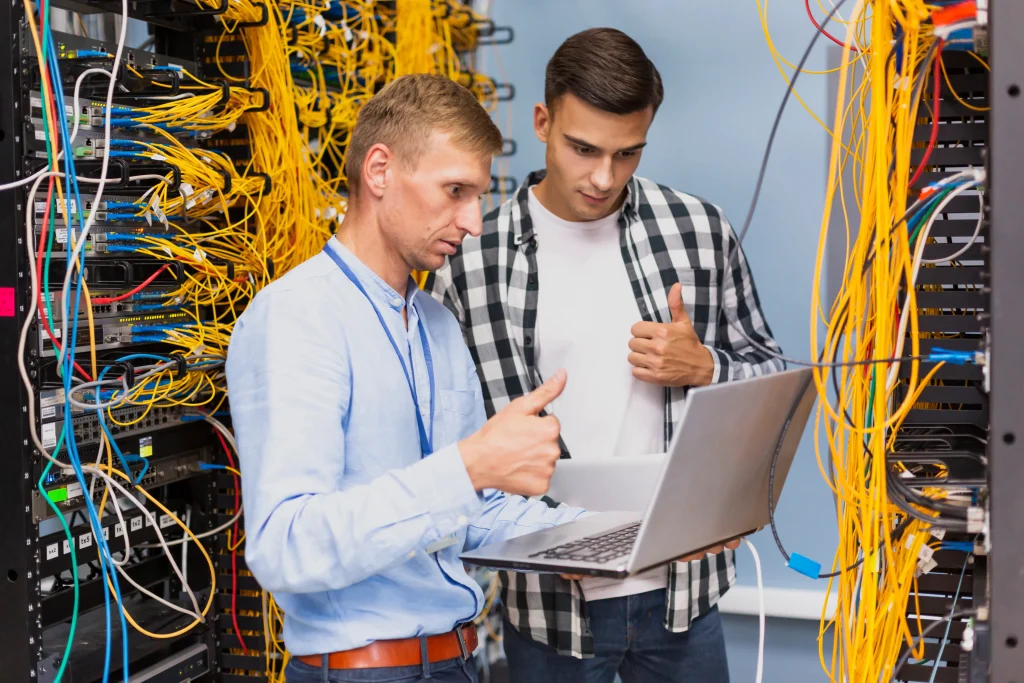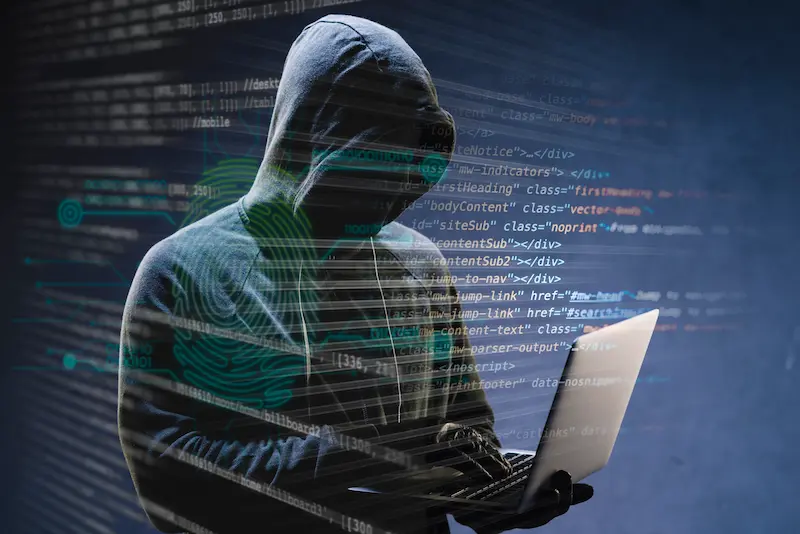Network Engineer MCQs are very useful for students and IT professionals who want to learn about computer networks. These multiple-choice questions cover important topics like OSI layers, IP addresses, routing, VLANs, and network security. Practicing Network Engineer MCQs helps you prepare for exams, interviews, and real-life networking tasks. The questions include both easy and tough topics, making it a good way to check your knowledge and improve your skills. Whether you are new to networking or have some experience, solving these questions will make you more confident and better at understanding networks.
60 Network Engineer MCQs

Q. Which layer of the OSI model is responsible for routing?
a) Data Link
b) Network
c) Transport
d) Application
Answer: b) Network
Q. What protocol is used to assign IP addresses dynamically?
a) DNS
b) DHCP
c) FTP
d) SMTP
Answer: b) DHCP
Q. Which of the following is a connectionless protocol?
a) TCP
b) FTP
c) UDP
d) HTTP
Answer: c) UDP
Q. What does VLAN stand for?
a) Virtual Local Area Network
b) Variable LAN
c) Virtual Link Access Network
d) Virtual Line Access Node
Answer: a) Virtual Local Area Network
Q. Which command is used to check network connectivity?
a) traceroute
b) ping
c) ipconfig
d) nslookup
Answer: b) ping
Q. Which protocol is used to securely access a remote computer?
a) FTP
b) SSH
c) Telnet
d) HTTP
Answer: b) SSH
Q. What is the default subnet mask for a Class C IP address?
a) 255.0.0.0
b) 255.255.0.0
c) 255.255.255.0
d) 255.255.255.255
Answer: c) 255.255.255.0
Q. Which device operates at the Data Link layer?
a) Router
b) Switch
c) Hub
d) Modem
Answer: b) Switch
Q. Which routing protocol uses the Bellman-Ford algorithm?
a) OSPF
b) EIGRP
c) RIP
d) BGP
Answer: c) RIP
Q. What is the port number for HTTP?
a) 21
b) 23
c) 80
d) 443
Answer: c) 80
Q. What does NAT stand for?
a) Network Address Translation
b) Network Access Terminal
c) Network Allocation Table
d) Network Authentication Technique
Answer: a) Network Address Translation
Q. Which protocol resolves IP addresses to MAC addresses?
a) DNS
b) ARP
c) ICMP
d) FTP
Answer: b) ARP
Q. Which layer handles encryption and decryption in the OSI model?
a) Presentation
b) Session
c) Application
d) Transport
Answer: a) Presentation
Q. What does BGP stand for?
a) Border Gateway Protocol
b) Basic Gateway Protocol
c) Binary Gateway Protocol
d) Broadcast Gateway Protocol
Answer: a) Border Gateway Protocol
Q. Which tool would you use to view active network connections on a Windows machine?
a) ipconfig
b) netstat
c) nslookup
d) tracert
Answer: b) netstat
Q. Which device segments a network into collision domains?
a) Hub
b) Switch
c) Router
d) Repeater
Answer: b) Switch
Q. What is the maximum transmission unit (MTU) size for Ethernet?
a) 1500 bytes
b) 512 bytes
c) 1024 bytes
d) 2048 bytes
Answer: a) 1500 bytes
Q. Which protocol sends echo request and echo reply messages?
a) TCP
b) ICMP
c) UDP
d) ARP
Answer: b) ICMP
Q. Which layer is responsible for end-to-end communication?
a) Network
b) Transport
c) Data Link
d) Physical
Answer: b) Transport
Q. What does SSL stand for?
a) Secure Sockets Layer
b) Secure System Layer
c) System Socket Layer
d) Secure Server Link
Answer: a) Secure Sockets Layer
Q. Which IP address class has the default subnet mask 255.255.255.0?
a) Class A
b) Class B
c) Class C
d) Class D
Answer: c) Class C
Q. Which protocol is primarily used for sending emails?
a) FTP
b) SMTP
c) SNMP
d) HTTP
Answer: b) SMTP
Q. What type of device is a firewall?
a) Layer 2 device
b) Layer 3 device
c) Security device
d) Physical layer device
Answer: c) Security device
Q. What is the purpose of the ARP protocol?
a) Resolves domain names to IP addresses
b) Maps IP addresses to MAC addresses
c) Transfers files
d) Routes packets
Answer: b) Maps IP addresses to MAC addresses
Q. Which command shows the current IP configuration on a Windows system?
a) ifconfig
b) ipconfig
c) ping
d) tracert
Answer: b) ipconfig
Q. What is a broadcast address?
a) An address that identifies a single device
b) An address that identifies all devices on a network
c) An address for routers only
d) A private IP address
Answer: b) An address that identifies all devices on a network
Q. Which protocol is used to resolve hostnames to IP addresses?
a) ARP
b) DHCP
c) DNS
d) FTP
Answer: c) DNS
Q. Which wireless standard operates at 5 GHz and supports up to 1 Gbps?
a) 802.11a
b) 802.11b
c) 802.11g
d) 802.11n
Answer: a) 802.11a
Q. What does the ‘traceroute’ command do?
a) Shows the route packets take to reach a destination
b) Displays the current IP configuration
c) Sends ping requests continuously
d) Displays DNS records
Answer: a) Shows the route packets take to reach a destination
Q. What is the main function of a router?
a) To connect devices in the same network
b) To connect multiple networks and route packets
c) To amplify signals
d) To filter spam emails
Answer: b) To connect multiple networks and route packets
Q. What is the primary purpose of a subnet mask?
a) To assign IP addresses
b) To define network and host portions of an IP address
c) To route traffic between networks
d) To secure the network
Answer: b) To define network and host portions of an IP address
Q. Which protocol is used for network management and monitoring?
a) FTP
b) SNMP
c) SMTP
d) DHCP
Answer: b) SNMP
Q. Which device can filter traffic based on MAC addresses?
a) Router
b) Switch
c) Hub
d) Bridge
Answer: b) Switch
Q. Which IP address is a private IP?
a) 8.8.8.8
b) 192.168.1.1
c) 172.217.0.0
d) 203.0.113.1
Answer: b) 192.168.1.1
Q. What is the maximum number of hosts on a Class C network?
a) 254
b) 256
c) 512
d) 1024
Answer: a) 254
Q. Which protocol is used to transfer files over the internet?
a) FTP
b) SMTP
c) HTTP
d) DNS
Answer: a) FTP
Q. What does a proxy server do?
a) Acts as an intermediary between clients and servers
b) Routes packets
c) Assigns IP addresses
d) Detects viruses
Answer: a) Acts as an intermediary between clients and servers
Q. Which type of address does IPv6 use?
a) 32-bit addresses
b) 64-bit addresses
c) 128-bit addresses
d) 256-bit addresses
Answer: c) 128-bit addresses
Q. What is the main difference between a hub and a switch?
a) Hub operates at Layer 2, Switch at Layer 1
b) Hub forwards data to all ports, Switch forwards data to specific ports
c) Hub is faster than Switch
d) Switch only connects wireless devices
Answer: b) Hub forwards data to all ports, Switch forwards data to specific ports
Q. Which protocol is used for remote desktop connections?
a) FTP
b) RDP
c) Telnet
d) SSH
Answer: b) RDP
Q. What is an IP address?
a) A unique identifier for a device on a network
b) A hardware address
c) A physical device
d) A protocol
Answer: a) A unique identifier for a device on a network
Q. What does ICMP stand for?
a) Internet Control Message Protocol
b) Internet Communication Management Protocol
c) Internal Control Message Protocol
d) Internet Connectivity Management Protocol
Answer: a) Internet Control Message Protocol
Q. What is the purpose of a default gateway?
a) To provide DNS services
b) To route traffic to outside networks
c) To assign IP addresses
d) To filter packets
Answer: b) To route traffic to outside networks
Q. Which tool helps identify open ports on a network?
a) nslookup
b) ping
c) nmap
d) tracert
Answer: c) nmap
Q. What is a MAC address?
a) A unique hardware identifier for a network interface
b) An IP address
c) A protocol type
d) A firewall rule
Answer: a) A unique hardware identifier for a network interface
Q. Which protocol is used for secure web browsing?
a) HTTP
b) HTTPS
c) FTP
d) SMTP
Answer: b) HTTPS
Q. What is the function of DHCP?
a) Resolves hostnames to IP addresses
b) Assigns IP addresses dynamically
c) Encrypts data
d) Routes packets
Answer: b) Assigns IP addresses dynamically
Q. Which layer of OSI handles flow control?
a) Transport
b) Network
c) Data Link
d) Session
Answer: a) Transport
Q. What does EIGRP stand for?
a) Enhanced Interior Gateway Routing Protocol
b) External Internet Gateway Routing Protocol
c) Extended Interior Gateway Routing Protocol
d) Ethernet Internet Gateway Routing Protocol
Answer: a) Enhanced Interior Gateway Routing Protocol
Q. Which of the following is a private IP address range?
a) 192.168.0.0 – 192.168.255.255
b) 8.8.8.8 – 8.8.8.8
c) 172.16.0.0 – 172.31.255.255
d) Both a and c
Answer: d) Both a and c
Q. Which protocol uses port 53?
a) HTTP
b) DNS
c) FTP
d) SMTP
Answer: b) DNS
Q. Which technology allows multiple virtual networks on a single physical switch?
a) VLAN
b) VPN
c) NAT
d) DHCP
Answer: a) VLAN
Q. What does MPLS stand for?
a) Multi-Protocol Label Switching
b) Multi-Port Layer Switching
c) Multi-Path Link Switching
d) Multi-Packet Label Service
Answer: a) Multi-Protocol Label Switching
Q. Which of the following protocols operates at the Application layer?
a) TCP
b) IP
c) HTTP
d) ARP
Answer: c) HTTP
Q. What is the primary function of a DNS server?
a) Assign IP addresses
b) Translate domain names to IP addresses
c) Route traffic between networks
d) Filter network packets
Answer: b) Translate domain names to IP addresses
Q. Which command would you use to display the routing table in Windows?
a) route print
b) ipconfig /all
c) netstat -r
d) tracert
Answer: a) route print
Q. Which type of firewall filters traffic based on IP addresses and ports?
a) Stateful firewall
b) Packet filtering firewall
c) Proxy firewall
d) Application firewall
Answer: b) Packet filtering firewall
Q. What is the purpose of SNMP?
a) Secure network connections
b) Manage and monitor network devices
c) Transfer files
d) Resolve IP addresses
Answer: b) Manage and monitor network devices
Q. Which device connects different networks together?
a) Switch
b) Router
c) Hub
d) Modem
Answer: b) Router
Q. What is the primary role of a VPN?
a) Speed up network traffic
b) Provide secure remote access over public networks
c) Assign IP addresses
d) Monitor network performance
Answer: b) Provide secure remote access over public networks
Wrapping Up
Practicing Network Engineer MCQs is a great way to strengthen your networking knowledge and skills. These questions help you understand important concepts like routing, IP addressing, VLANs, and network security. Regular practice not only prepares you for exams and interviews but also builds confidence in solving real-world networking problems. By reviewing both easy and challenging questions, you can identify areas where you need improvement and track your progress. Whether you are a beginner or an experienced professional, solving Network Engineer MCQs regularly ensures you stay updated and sharp in the field of computer networking.





